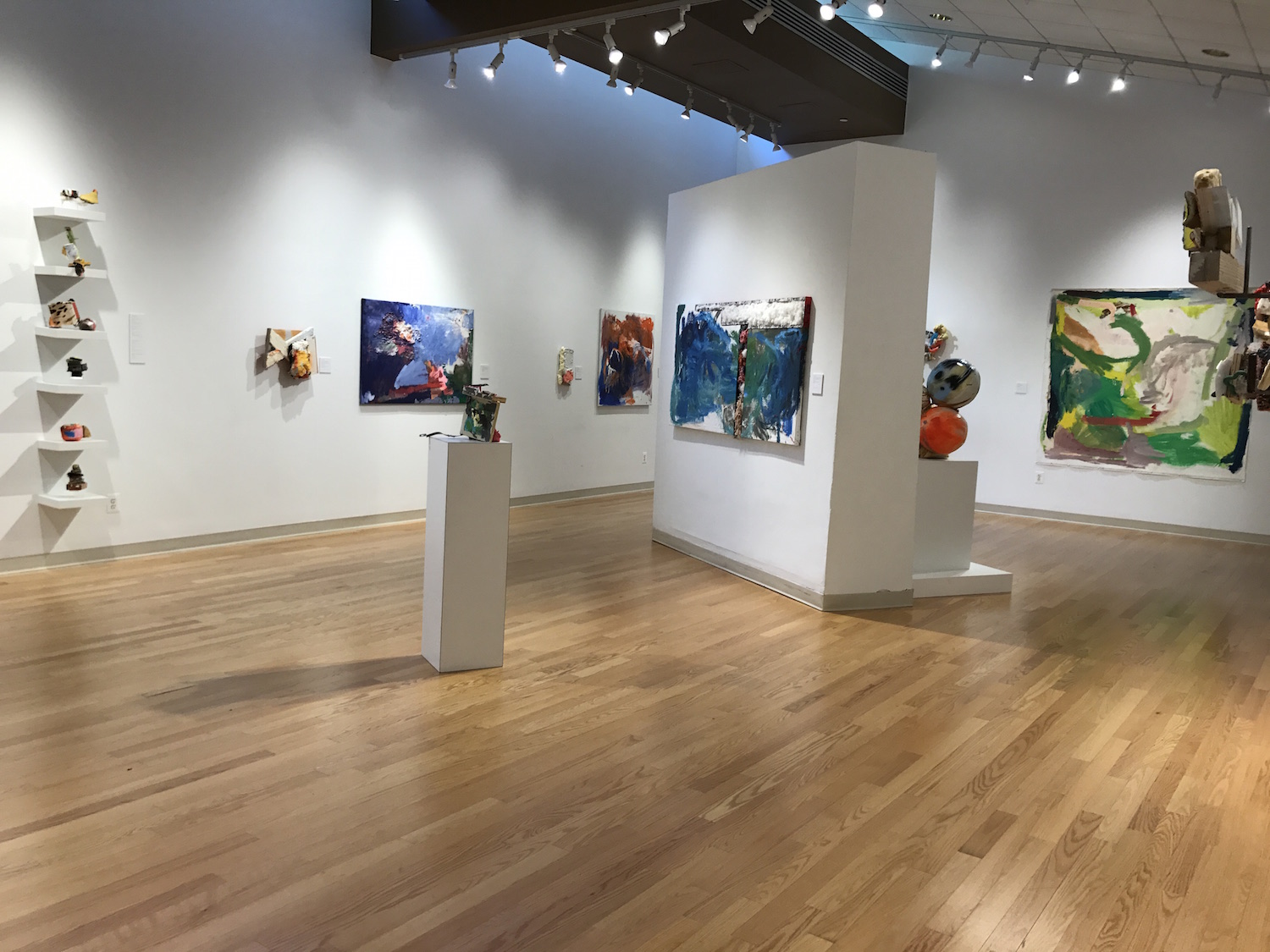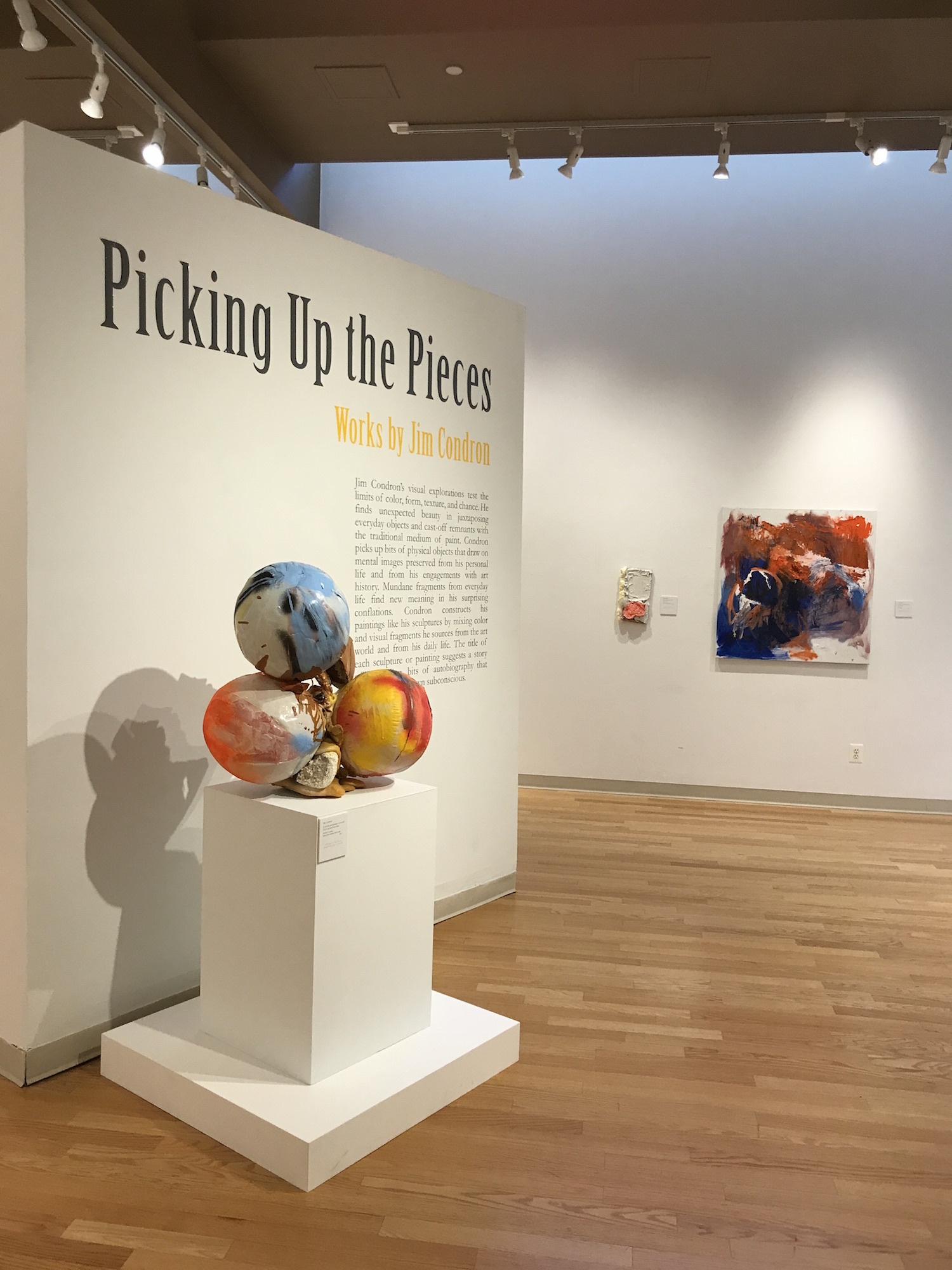Jim Condron: Picking Up the Pieces, An Exhibition review by J. Susan Isaacs
Jim Condron’s recent exhibition, Picking Up the Pieces, is simultaneously elegant, boisterous, witty, and moving. The show demonstrates not only Condron’s innate skill, but also what an artist can do when given the time and means to produce a body of work. Condron is a recent recipient of a Pollock Krasner Foundation grant, an Adolf and Esther Gottlieb Foundation grant, and a Maryland State Arts Council grant for sculpture. Picking up the Pieces includes his work of the last three years, but much of it is from 2016-17.
The installation, designed by the artist, presents painting and sculpture together, drawing a close relationship between the two. Some of this connection is dependent upon the placement of the works, but much of it relates to the facts that the sculptures bring many of the forms in the paintings to three-dimensional existence, and that they demonstrate the same kind of exultant color and gestures present in the paintings. At times, the paintings themselves contain sculptural elements. Not content with a solely formal presentation, Condron also assigns narrative titles to each object; the title of the show suggests deeper meanings too.
Indeed, each painting or sculpture offers possible tales even before reading the titles, prominently placed on labels next to the works. The gallery also includes the more contemporary checklist for viewers, but the labels are elegantly designed and positioned with intention. The message is that the titles matter, though they are not necessary to enjoy the work nor to recognize that something beyond form and color is present. Condron keeps a running list of titles which he creates from sentence fragments taken from books he has read. The titles are important to him, but they are assigned after each work is completed. The independence of the texts from their original sources creates a temporal dislocation echoed in the works themselves.

“So I was full of trouble, full as I could be; and didn’t know what to do” is a large painting/construction that includes down feathers, wool, wood, and linen. It is a seascape interrupted by an architectural form filled with yarn and feathers. Perhaps there was a shipwreck? A wonderfully executed expressionist painting, it also operates on a narrative plane, suggesting, though not overtly telling, a story of difficulty, even one of tragedy. The epic poem of Odysseus/Ulysses comes to mind. Yet, the Dadaesque mixing of images and objects offers an absurdist humor and the painting retains a kind of childlike delight.

Similarly, “she was interested in his work. But it really doesn’t matter what he did, he could have been an anthropologist,” demonstrates the same kind of combination of lyricism and the comedic. Condron bases this painting on the story of two Christian martyrs, the brothers Cosmas and Damian, the patron saints of physicians, pharmacists, and dentists, who lived in the 3rd century C.E., during the rule of the Roman emperor Diocletian, an avowed anti-Christian. Trained as doctors in Syria, the twin brothers treated the sick for free, and they are credited with many miracles. They were persecuted and tortured and attempts to drown the brothers and to burn them were ineffective. Ultimately, they were decapitated. The specific narrative of interest in this work is that depicted by Zanobi Strozzi, in “Sts Cosmas and Damian Saved from Drowning from the early 15th century.” After being thrown off a cliff, the brothers undid the bindings around their hands and feet and emerged free from the sea. Condron pairs this painting with a sculpture, “Live as if you’d drop dead in ten seconds. See the world. It’s more fantastic than any dream made or paid for in factories.”
The painting recalls landscapes by such 19th century artists as Frederick Edwin Church and Thomas Moran. It shares their asymmetrical compositions and flair for the dramatic with references to the sublime. Condron builds up his surface beyond a heavy impasto, using foam to create actual depth, not just implied depth. He sets explosive contrasts of color, from hot pink to red to various shades of blue and brown. It is a tragic scene, though its reference to the sublime is contradicted by the bright palette and thick areas of foam. The sculpture to its left, “Live as if you’d drop dead”…. implies the cross and martyrdom.
Questions are posed: Are artists martyrs to capitalism even though their chosen career makes them no different than a plumber or an anthropologist? Are we not all subject to tragedy? Should we not all live as if each day is our last? While these ideas are presented with humor, they are not unimportant.
Through his combination of the absurd with the sublime, Condron explores narratives not only specific to being an artist but also those shared by all of us. The balancing of the serious with the comedic is one of the strengths of Condron’s work.

Near this associated grouping of painting and sculpture is another work that seems connected with the sea, “there was [sic] things which he stretched, but mainly he told the truth.” It is a painted sculpture, made dimensional through wood, foam, and cement. The body of the boat is an arc with attached “ribs” that form a sail and oars. The shadow on the wall from this sculpture emphasizes its boat-like shape, and recalls galley ships rowed in antiquity. Foamy clouds physically join and burst through the “sail.” The dramatic shadow it casts on the wall emphasizes a sea-craft silhouette. Catty-corner to this work is an expressionist painting that also addresses truth and falsehood, “it’s a lot of funnels and a lot of water poured down the spout and out the bottom, and them telling us it’s wine when it’s not.”
Sculpture is an important voice in this exhibition and in the artist’s recent work. The individual objects form a whole. However, each has its own character too. Not only is there a relationship between painting and sculpture, but there is a link to the past, to Neo-Dada and Funk three-dimensional works of the early sixties as well.
Condron reminds us that we have a history, not to be forgotten, but to be used to anchor us in the present and point us to the future. Several presentation methods, from object specific shelving, elegant cases, and uniquely-crafted metal wall mounts that push the sculptures forward about eight inches from the wall, contribute to the strength of the installation. He makes objects that often wittingly reference something useful. Their humor and bright colors charm viewers. Taken together with the paintings, these often-whimsical constructions contribute to the joy of the exhibition. This body of work places Condron as a seeker of knowledge. How do we survive in a complex and difficult world? He strives to answer this through his artwork, and though it represents his own personal journey, we are lucky that he shares it with us.

Exhibition up through November 27, 2017
Julio Fine Arts Gallery
Loyola University Maryland
4501 N. Charles Street
Baltimore, MD 21210
Gallery hours during the academic year:
11 a.m. – 5 p.m. Mondays, Wednesdays, Fridays
11 a.m. – 7 p.m. on Tuesdays and Thursdays
1-4 p.m. on Saturday and Sunday.
Closed on University holidays.








